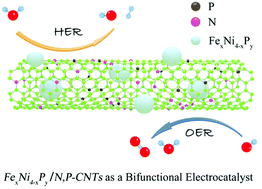An FexNi4−xPy/N, P co-doped carbon nanotube composite as a bifunctional electrocatalyst for oxygen and hydrogen electrode reactions†
Abstract
Designing bifunctional electrocatalysts with high-efficiency for catalyzing oxygen and hydrogen evolution is immensely desirable but challenging. Herein, a newly designed hybrid bifunctional electrocatalyst, FexNi4−xPy coupled with N,P-codoped carbon nanotubes (N, P-CNTs), is developed by a facile pyrolysis-phosphorization process. The FexNi4−xPy/N, P-CNT catalyst shows a small overpotential of 266 mV to attain the benchmark 10 mA cm−2, low Tafel slope, and excellent stability for OER in 1.0 M KOH electrolyte, preceding that of commercial IrO2. Moreover, the FexNi4−xPy/N, P-CNT catalyst also exhibits admirable activity and robust stability towards HER in alkaline media. The advantageous characteristics of high electrical conductivity, multicomponent active sites, and anchoring effects of carbon nanotubes synergistically contribute to the excellent electrocatalytic activities and stability of FexNi4−xPy/N, P-CNTs towards OER and HER. This study may pioneer a unique avenue to synthesize novel electrocatalysts featuring multicomponent active sites for applications in renewable energy techniques.



 Please wait while we load your content...
Please wait while we load your content...